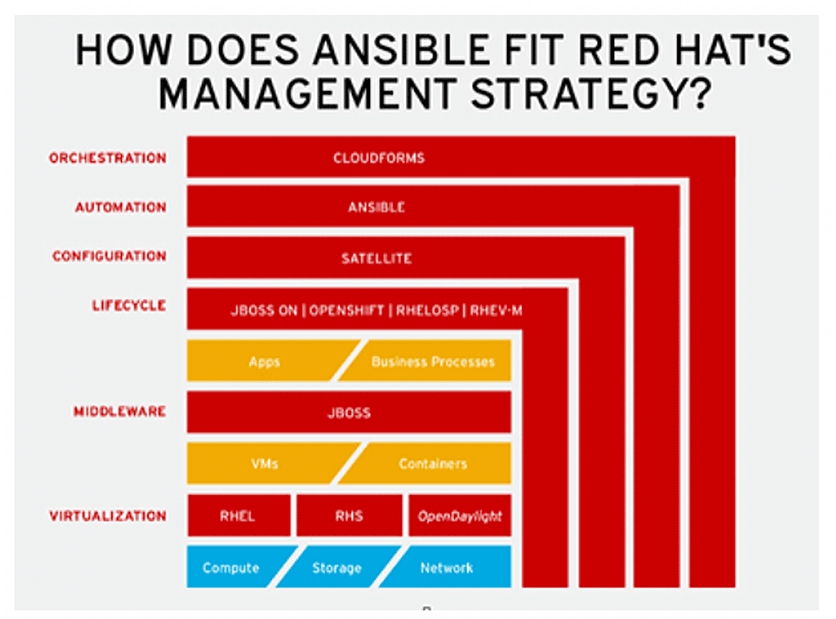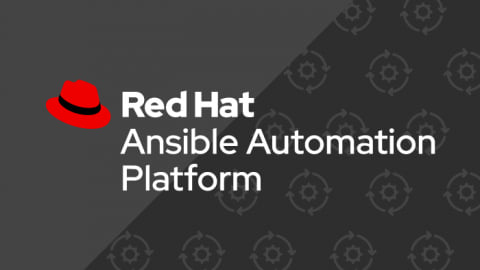Storage Engineer
Anyone with any length of time in Information Technology (IT) knows that we all are continually being asked to do more with less (resources, budget, headcount, etc.), so we must constantly learn to work smarter to keep pace with the new demands placed upon us by our respective businesses. What if you could automate your redundant or difficult IT tasks? I’m not referring to the latest DARPA robot, rather a manner to help you get your work done each day and focus on new business demands.
That tool is Red Hat Ansible Automation Platform (AAP), the clear leader in IT automation. What does your enterprise utilize for IT automation? Did your mind just drift to programming language automation and sorting through thousands of lines of code? No worries. Ansible does not require you to know any programming language and is quick to learn and implement. Ansible Automation Platform was developed for running your infrastructure as code (IAC), collecting all your enterprise system information, provisioning devices, and providing configuration management, all while simplifying repeatable and error-prone tasks. Ansible Automation Platform is based upon open-source code streams, and customers across the globe are switching to Ansible Automation Platform, from Puppet and Chef, to rapidly deploy IT automation. Additionally, Ansible Automation Platform is functional across all IT silos. So it works for network automation, storage automation, Dev/Ops automation, even IT security automation. Why not leverage enterprise automation? Does your enterprise purchasing strategy default to best-of-breed product sets? If yes, why not utilize the best IT automation, which is Ansible Automation Platform, and break down traditional IT silos at the same time? How much money can be saved by moving away from all your silo-based IT tools?
Playbooks and YAML
The foundation of Ansible is YAML. So, what is YAML (aka YAML Ain’t Markup Language)? YAML is a human-readable data serialization language commonly used for configuration files. It is used in many applications where data is being stored (i.e., debugging output) or where data is transmitted. YAML is human readable to help with troubleshooting and is thus easy to read — anyone can open them and understand the flow and thus the logic and what is the expected tasks and outcomes for each playbook. YAML is used within Ansible to create Playbooks, which you could think of as to-do lists for tasks. In YAML, syntax is vital, so even a misplaced ‘space’ can have meaning. Since YAML is not the focus here today, to learn more about YAML, you can go to https://yaml.org.
Ever notice how IT projects evolve over time from their original design? Morphing the design via a multitude of new components and, potentially, scale results in more complexity than intended. Unfortunately, this is normal in IT life cycle growth patterns. What if you had a framework that aided you in understanding the original design scope and deployment logic years after initial project deployment has been completed. This is all possible with Ansible Automation Platform, the tool for all your IT automation requirements.
Rapidly Deploy IT Automation
As your legacy IT environment transforms into a modern architecture, knowing full well this includes your hybrid data centers, you might find your requirement for multi-tier deployments growing or exploding. How are you planning to handle these complex rollouts? IT Automation is crucial to tackling complexities in single and multi-tier deployments, regardless of whether the deployments are on-premises or in multi-cloud environments. Automation is also vital to ensure that tasks and projects go efficiently and are repeatable while not producing extra cloud utilization or higher-than-intended costs. Ansible Automation Platform can also be utilized to ease complexity while decreasing human errors. How many benefits have you already identified for your enterprise? Several long-term IT studies have shown human errors have accounted for up to 80% of all IT errors. To decrease the frequency and impact of such errors, IT automation by Ansible should be leveraged to free you up from mundane or difficult repeatable tasks and shift your focus onto architecting for new IT demands… not just keeping the lights on! Ansible provides several ways in which to ‘test’ the impact of your proposed changes, allowing you to know the impact prior to deployment deadlines.
How valuable is the reduction of the number of errors when provisioning a Greenfield site or replacing data center core gear to your management team? I assume it is near the top of their requirements for IT daily. Now you can demonstrate changes during your change management meetings and not when they are being rolled to production.
So, what types of IT can Ansible Automation Platform automate? I am glad you asked. Your enterprise can take advantage of automation to networking gear (Routers, Switches, Firewalls, IDS/IPS, IPAM, Wi-Fi, etc.), Storage (Block File & Object), Security (IAM, SIEM ((Splunk, QRADAR))), Cloud offerings (AWS Cloud Formation, Azure Infrastructure as Code), Ops teams (DevOps, SecOps,) etc. Or perhaps your databases are growing by order of magnitude and you require a prescriptive manner to deploy and config these instances (Cassandra, Oracle, MS SQL, PostgreSQL). Ansible Automation Platform can help there too. What about aiding in the deployment of Kubernetes (K3s, K8s) or Docker clusters by tracking all those coding changes and thus impacting your micro-services environments?
If you oversee CI/CD pipelines, can you visualize the impact to your release schedules using a tool like this? If you have a task that must be repeated twice or more, it should be automated using Ansible. If you have a task that is only performed quarterly or annually, there is a high likelihood it could be error prone and should be automated; eliminate as much risk as possible prior to these scheduled events. Think of all those legacy scripts in Bash, Perl, C++, JAVA, etc. that can be converted to this Ansible Automation Platform, making it even more powerful to your enterprise each day.
One aspect of the modern data center that we aid enterprises in is how to modernize their data protection environment. Does your backup tool support Ansible? Or does it not play well with others? If not, let’s talk about moving your enterprise backup to Cohesity or Rubrik platforms, as both are web-scale data protection offerings and support Ansible all while simplifying your data protection offering and rapid restore requirements. Perhaps you are more concerned about enterprise configuration management, as you know it requires a consistent, repeatable secure manner. Maybe you need clarity on how IT automation can help your enterprise. Well, Ansible is the simplest by design… even IT managers can get Ansible to work. Ansible automation platform is goal oriented, not scripted; it comes with over 3000 modules to help get you started day one, not day seven or even day 30.
How Ansible Works
How exactly does Ansible Automation Platform work? Ansible is agentless… thus no host performance or security impact like other agent-based automation offerings. Nor does it require Root level access to run. Furthermore, it provides a smaller attack vector, providing less risk and more acclaim for you from your InfoSec team. Does the agent-based automation tool you are evaluating react to unauthorized config changes? Ansible can react and put the approved config back, even for multi-tier changes. Yet another use-case for Ansible would be to utilize it to speed your digital transformation journey and automation journey. Ansible Automation Platform has minimal server requirements (Control servers) and doesn’t require daemons or databases. Ansible communicates to network, hosts, and end nodes by way of SSH or WinRM communications. All you need is SSH username and passwords and you are off and running with Ansible, gathering information and potentially making changes. Essentially, there are 3 ways to run Ansible interactions on devices. These are ad-hoc or the passing of raw commands or modules; Ansible Playbooks, which we briefly covered above; and, the most scalable option, via the Automation platform, which is a central point for all things Ansible.
Let’s dive deeper into Ansible Technical information.
From an operating system standpoint, it supports the following:
- Red Hat or similar distro that utilizes yum – sample command yum install ansible
- AWS install utilize sudo amazon-linux-extras install ansible2 (~9M download w/ 44M space)
- Debian or Ubuntu utilize apt-get install ansible
- Non-yum based distro utilize pip install ansible
You can install Ansible Automation Platform in under 30 minutes and then begin to automate your mundane and difficult tasks by leveraging the 3000+ modules. One of the best practices in the Ansible community is to never reinvent the wheel. I recommend that you join the Ansible Galaxy community and see what others have built already for what you are attempting to accomplish. Download it, modify it for your specific needs, test it and deploy it. Do not overlook checking back into the community from time to time for additional projects that others have already built and shared since you were last back on. Lastly, do not forget to share what you have built within the community, as a manner of giving back.
Ansible Automation Platform Positioning with Red Hat Offerings
You might be thinking… we could exploit this tool for this or that, within our enterprise, but where exactly does it fit in the grand scheme of offerings from Red Hat? The visual below shows the tight coupling of Ansible and other Red Hat products.

Ansible Automation Platform is the enterprise automation tool for controlling, securing, and managing Ansible Automation. It captures all Ansible output and is the central repository and automation hub for everything Ansible, allowing for team sharing of jobs, log aggregation, etc. Ansible Automation Platform can even integrate with ticketing and orchestration systems, such as ServiceNow, to aid your enterprise in understanding where IT bottlenecks exist.
Ansible Automation Platform is a licensed product from Red Hat and is licensed by the number of managed end nodes, which comes in 2 flavors: Standard and Premium. The difference is that the premium support offering comes with 24-hour and playbook support model. Both types of licenses are available in blocks of 50, 100, 250, 500, 1000+ nodes. Work with your Business partner to get Ansible Automation Platform pricing and get started using Ansible.
Summary
In summary, while Ansible is an open-sourced product and is free for unlimited nodes, Ansible Automation Platform is a licensed offering based upon licensed nodes. Ansible automation platform pulls together all the Ansible data to a central point for all IT silos to leverage. Since you can get Ansible up and running in 30 minutes, isn’t it about time you invest in fully Automating IT with just one tool? Ansible provides value regardless of Greenfield or Brownfield deployment cycles. Why not utilize the best IT enterpries automation Framework to break down traditional IT Silos? Ansible Automation Platform: the one tool to unite all of IT!
More Information
Mainline is a Platinum level IBM Business Partner, the highest level in the PartnerWorld program, with proven expertise to help you solve your business challenges with IBM offerings, including Red Hat enterprise open source solutions. We help our customers optimize their businesses by using Ansible, OpenShift, and RHEL.
For more information on Red Hat solutions, please contact your Mainline Account Executive directly, or click here to contact us with any questions.
You may also be interested in:
OnDemand Video: Red Hat Ansible Automation Platform (19:50)
OnDemand Video: Automating IBM Power Systems Cluster Install using Red Hat Ansible (27:00)
BLOG: Red Hat OpenShift on LinuxONE and IBM Z running under KVM

